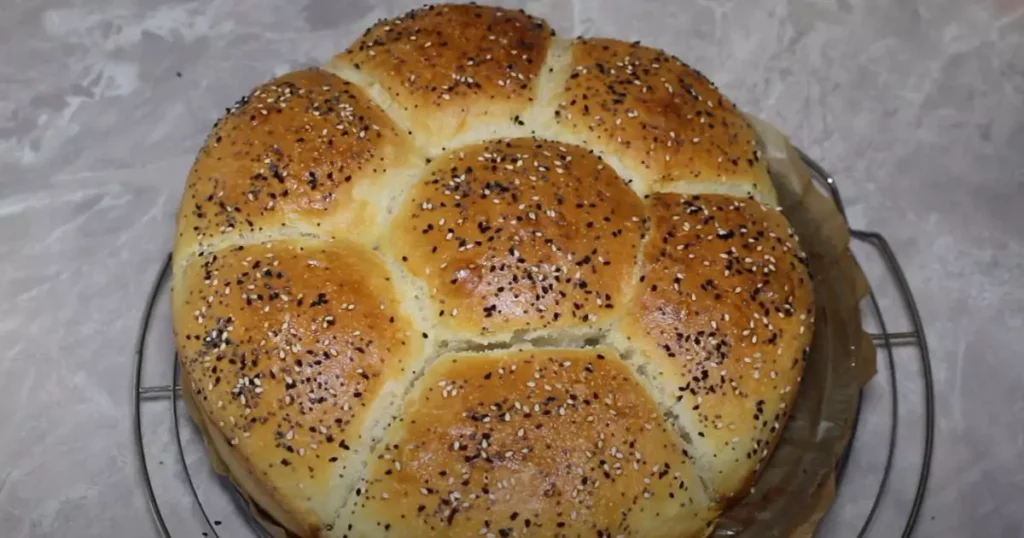
Welcome to the delightful and rewarding world of croissant baking! Whether you’re an enthusiastic beginner or an intermediate baker ready to take on a new challenge, this guide is designed to demystify the art of crafting these buttery, flaky pastries. Croissants, with their golden crust and tender layers, are often seen as the pinnacle of baking prowess, yet with patience and guidance, they are within your reach.
In this journey, we’ll take it step by step, ensuring that each part of the process is clear and approachable. Making croissants is a labor of love and a test of patience, spanning over three days. This time allows for the dough to develop its flavors and for the butter to remain perfectly laminated within the layers. The joy of seeing your homemade croissants emerge from the oven, golden and fragrant, is an unmatched culinary achievement.
We invite you to roll up your sleeves, embrace the learning process, and discover the joys of baking croissants from scratch. Remember, every baker starts somewhere, and each mistake is a stepping stone to mastery. Let’s begin this exciting baking adventure together!
Demystifying Croissant Baking
Croissant making is often viewed as a complex task reserved for professional bakers. However, with this guide, we aim to simplify the process, breaking it down into manageable steps that even a beginner can follow. Understanding the key stages and what to expect makes the task less daunting and more enjoyable.
1. Understanding the Timeline
- Three-Day Process: The croissant-making journey is spread over three days, allowing for sufficient resting and proofing times. This slow process is crucial for developing flavor and texture.
- Active and Inactive Times: There is about 90 minutes of active work, such as mixing and rolling the dough. The inactive time, including resting and proofing, adds up to about 5 hours, excluding overnight rests.
2. The Role of Each Ingredient
- Butter: The star of the show. It provides the croissants with their signature flaky layers and rich flavor. Keeping the butter cold is essential for successful lamination.
- Yeast: It helps the dough rise and develop its airy structure.
- Flour, Milk, Water, Sugar, Salt: These foundational ingredients create the dough’s base, offering structure, taste, and texture.
3. Key Techniques Explained
- Lamination: This refers to the process of folding butter into the dough multiple times to create thin layers. The quality of your lamination will directly affect the flakiness of the croissants.
- Proofing: Allowing the dough to rise at the right temperature is critical. It helps in developing the right texture and ensures that your croissants are light and airy.
4. Patience is Key
- Resting Periods: The dough needs time to rest and chill. This prevents the butter from melting and ensures that the layers don’t merge together.
- Taking It Slow: Rushing the process can lead to common problems like butter leakage. It’s important to work methodically and patiently.
5. Final Baking
- Achieving the Perfect Color and Texture: The final baking stage is where you see your efforts come to fruition. Achieving that golden brown crust and airy interior is the culmination of all your hard work.
In summary, while making croissants requires time and attention, it’s a process that can be simplified and enjoyed. With the right approach and mindset, you’ll find that making croissants at home is not only possible but also incredibly satisfying.
Essential Tools for Croissant Making
Having the right tools at hand is crucial for the successful execution of croissant baking, especially for those who are new to this culinary art. Let’s explore the essential tools and offer practical alternatives where possible.
1. Parchment Paper
- Purpose: Parchment paper is used to create a butter block and to roll out the dough. It helps in maintaining shape and ensures easy handling.
- Alternatives: If parchment paper is unavailable, you can use a silicone baking mat or a clean, lightly floured cloth.
2. Rolling Pin
- Importance: A heavy rolling pin is necessary for evenly rolling the dough and laminating the butter.
- Choosing the Right One: A heavy wooden or marble rolling pin works best. If you don’t have a heavy rolling pin, you can use a standard one, but you may need to apply more pressure.
3. Sheet Pans
- Usage: Quarter and half sheet pans are used for chilling and baking the dough. They ensure even heat distribution during baking.
- Substitutions: In the absence of sheet pans, you can use any flat baking tray of a similar size, as long as it fits in your fridge and oven.
4. Ruler
- Precision: A ruler with clear cm and inch markings is necessary for measuring dough and butter. This ensures uniformity in your croissants.
- Simple Alternative: If a steel ruler is not available, any clean, straight-edged ruler will work. Consistency in measurement is key.
5. Sharp Knives and Pizza Cutter
- Function: Used for cutting dough and butter. Sharp edges ensure clean cuts without dragging the dough.
- Kitchen Alternatives: A sharp chef’s knife or any sharp blade can be used if a paring knife or pizza cutter is not at hand.
6. Pastry Brush
- Role: For applying egg wash. A good brush ensures even coverage without deflating the dough.
- Finding a Substitute: If a pastry brush isn’t available, a small, clean paintbrush or even the back of a spoon can be used in a pinch.
Equipping your kitchen with these tools will prepare you for the croissant-making process. While specialized baking tools are helpful, don’t let the lack of them deter you. Resourcefulness and adaptation are key traits in baking. Remember, it’s not just about having the perfect tools but using what you have effectively.
Ingredients Explained Simply
Understanding the role of each ingredient in croissant making is crucial, especially for beginners. Let’s simplify what each ingredient does and why it’s important for your croissant success.
1. Milk and Water
- Role: They create the base of your dough, called ‘Détrempe’. Milk enriches the dough, adding flavor and tenderness, while water provides moisture without additional fat.
- Tip: Use lukewarm liquids to help activate the yeast more effectively.
2. Active Dry Yeast
- Purpose: Yeast is the magical ingredient that makes the dough rise. It feeds on the sugars and creates air bubbles, leading to fluffy croissants.
- Note: Ensure your yeast is fresh for the best results. Expired yeast can lead to flat, dense croissants.
3. Honey, Malt Syrup, or Sugar
- Function: These sweeteners feed the yeast, aiding in fermentation and browning of the croissants. They also add a subtle sweetness.
- Variations: Honey and malt syrup can add distinct flavors, while sugar is more neutral.
4. Butter (For Détrempe and Tourrage)
- Key Ingredient: Butter in the dough adds richness and flavor. The separate butter block (Tourrage) creates the flaky layers.
- Importance of Temperature: Keep the butter cold for Tourrage. This helps maintain distinct layers in your croissants.
5. AP Flour
- Foundation: All-purpose flour forms the structure of your croissants. It’s strong enough to hold the layers but not so high in protein that it makes the pastries tough.
- Measuring Tip: Use the spoon and level method for accurate measurement. Compacted flour can make the dough too heavy.
6. Salt
- Enhancer: Salt not only enhances flavor but also strengthens the gluten network in the dough, giving your croissants a good texture.
- Balancing Act: A proper balance of salt is key; too little can result in bland croissants, while too much can inhibit yeast activity.
7. Egg Yolk and Milk/Cream (For Egg Wash)
- Finishing Touch: The egg wash gives croissants their signature golden, shiny crust. It’s brushed on right before baking.
- Combination: The yolk adds color, while milk or cream provides a rich shine.
Each ingredient in croissant making plays a specific and important role. Understanding these roles helps demystify the process and sets you up for success. Remember, baking is as much about science as it is about art – the precision in your ingredients will reflect in the quality of your croissants.
Step-by-Step Guide to Making Croissants with Ingredients

Follow this detailed, step-by-step guide, complete with ingredient quantities, to create your own croissants.
1. Making the Détrempe (Dough)
- Ingredients:
- 70.83 g milk (0.28 cup), lukewarm
- 4.17 g honey (0.83 tsp)
- 5 g active dry yeast (about 1.67 tsp)
- 50 g water (0.21 cup)
- 20.83 g butter (1.25 tbsp), melted and cooled
- 16.67 g white sugar (generous 1.25 tbsp)
- 208.33 g AP flour (1.67 cups, spoon and leveled)
- 4.17 g salt (about 0.83 tsp)
- Activating the Yeast: Dissolve honey in lukewarm milk in a mixing bowl. Whisk in the yeast and set aside for 10-20 minutes for activation.
- Combining the Ingredients: Add water, melted butter, sugar, flour, and salt to the yeast mixture. Stir to form a shaggy dough.
- Kneading: Knead on a lightly floured surface for about 4 minutes until smooth.
- First Proof: Let the dough rise in a warm place until doubled (about 1 hour).
2. Preparing the Dough for Lamination
- Shaping and Chilling: Flatten the proofed dough to release air. Shape it into a rectangle on a large parchment paper, cover and freeze for a few hours or overnight.
3. Making the Tourrage (Butter Block)
- Ingredients:
- 116.67 g butter (8.33 tbsp)
- Slicing and Arranging Butter: Slice cold butter and arrange on smaller parchment paper within a 5 x 6.5-inch rectangle. Fold the paper over the butter.
- Rolling the Butter: Firmly hit with a rolling pin, then roll out evenly. Refrigerate until hard.
4. Enclosing the Butter
- Laminating: Soften the dough slightly. Place the butter block on half of the dough, fold over, and seal edges. Chill if not cold.
5. First Lamination (Double Fold)
- Rolling Out the Dough: Flour the surface and dough. Roll out to 16 inches in length, keeping a 5-inch width.
- Folding: Fold ends towards the middle, then fold in half. Refrigerate for 30 minutes.
6. Second Lamination (Single Fold)
- Repeating the Process: Roll out the dough to 15 inches in length. Fold one-third of the dough towards the center, then the other third over it. Refrigerate for 30-60 minutes.
7. Sheeting the Dough
- Final Roll Out: Roll the dough on a floured surface to about 1 cm thickness, then refrigerate for 30-45 minutes.
- Achieving the Right Thickness: After resting, roll the dough to 4-5 mm thickness.
8. Cutting the Dough
- Trimming and Marking: Trim to a 9-inch width. Make 3.5-inch interval markings on both long edges.
- Cutting Triangles: Connect markings and cut out triangles.
9. Rolling and Proofing Croissants
- Shaping: Roll up each triangle from the base to the tip.
- Proofing: Place on a baking sheet, cover, and proof until doubled (2-3 hours).
10. Baking the Croissants
- Ingredients for Egg Wash:
- 0.83 egg yolk
- 1.67 tbsp milk and/or cream
- Preheating and Egg Wash: Preheat oven to 375°F (190°C). Mix egg yolk and milk for the egg wash and brush over croissants.
- Baking: Bake for 20-30 minutes until golden brown. Cool on a wire rack.
Congratulations! You’ve now completed the intricate process of making croissants. This journey requires patience and precision, but the end result – flaky, buttery croissants – is well worth the effort.
Solving Common Croissant Baking Problems
Even experienced bakers can encounter issues when making croissants. Let’s address common problems and provide simple solutions.
1. Butter Leaking Out During Baking
- Cause: This often happens if the butter gets too warm during the lamination process or if the layers aren’t sealed properly.
- Solution: Ensure the dough and butter are cold during lamination. Chill the dough between folds and before baking. Seal the edges of the dough well when enclosing the butter.
2. Croissants Not Flaky Enough
- Cause: Insufficient lamination, overworking the dough, or using butter with too low a fat content can lead to this issue.
- Solution: Be precise during the lamination process, creating distinct layers of dough and butter. Use high-quality butter with a higher fat content. Handle the dough gently.
3. Croissants are Too Dense
- Cause: Underproofing the dough is a common reason for dense croissants.
- Solution: Allow enough time for the croissants to proof until they double in size and feel light and jiggly. This could take longer in colder environments.
4. Dough is Difficult to Roll Out
- Cause: Dough that’s too cold or hasn’t rested enough can be tough to roll.
- Solution: Let the dough rest for sufficient time in the fridge between laminations. If it’s too hard, let it sit at room temperature for a few minutes to soften slightly.
5. Croissants Losing Shape While Baking
- Cause: This can occur if the croissants are overproofed or if the oven temperature is too low.
- Solution: Proof the croissants just until they double in size. Make sure your oven is preheated to the correct temperature. Placing a baking stone or an additional baking sheet in the oven can help maintain a stable temperature.
6. Uneven Browning
- Cause: Uneven oven temperature or incorrect egg wash application can lead to this.
- Solution: Turn the baking sheet halfway through baking for even heat distribution. Apply egg wash gently and evenly.
7. Croissants are Not Rising Properly
- Cause: Old yeast or incorrect oven temperature can be the culprits.
- Solution: Always check the freshness of your yeast. Use an oven thermometer to ensure the baking temperature is accurate.
Remember, making croissants is a learning process, and even small mistakes can teach valuable lessons. With practice and attention to these tips, you’ll be on your way to making perfect croissants.
FAQs for First-Time Croissant Bakers
For those embarking on their first croissant-making adventure, certain questions often arise. Here are answers to some of the most common queries to guide you along the way.
1. How Do I Know if My Yeast is Activated?
- Answer: Active yeast should become foamy and bubbly after sitting in the warm milk and honey mixture for about 10-20 minutes. If there’s no activity, the yeast may be expired and should be replaced.
2. Can I Use Instant Yeast Instead of Active Dry Yeast?
- Answer: Yes, you can use instant yeast. The primary difference is that instant yeast doesn’t need to be activated in liquid first and can be mixed directly with dry ingredients.
3. Why is Temperature Control So Important in Making Croissants?
- Answer: Temperature control is crucial because it keeps the butter from melting into the dough. Cold butter ensures the creation of distinct, flaky layers in the croissants.
4. How Can I Tell if I’ve Proofed the Croissants Enough?
- Answer: Properly proofed croissants will be noticeably larger (about double in size), feel light and puffy, and jiggle slightly when the baking sheet is gently shaken.
5. My Croissants Are Not as Flaky as I Expected, Why?
- Answer: This could be due to insufficient lamination, overworking the dough, or not chilling the dough adequately between folds. Ensure you create distinct layers and handle the dough gently.
6. What’s the Best Way to Store Baked Croissants?
- Answer: Croissants are best enjoyed fresh, but you can store them in an airtight container at room temperature for up to 2 days. For longer storage, freeze them and reheat in the oven.
7. Can I Freeze Croissant Dough for Later Use?
- Answer: Yes, you can freeze the laminated dough. Wrap it tightly in plastic wrap and freeze for up to 2 months. Thaw overnight in the refrigerator before proceeding with the final rolling, shaping, and baking.
8. How Do I Get a Shiny, Golden Brown Finish on My Croissants?
- Answer: Apply an egg wash (a mixture of egg yolk and milk or cream) evenly over the croissants before baking. This gives them a shiny, golden finish.
9. Can I Make Croissants Without a Stand Mixer?
- Answer: Absolutely! Croissants can be made entirely by hand. It might require more effort, especially during the kneading stage, but it’s entirely feasible.
These answers should help clear up some of the uncertainties you might have as a first-time croissant baker. Remember, making croissants is as much about the journey as the destination, so embrace the process and enjoy your baking adventure!
Conclusion
Congratulations on taking the first steps in your croissant baking journey! This intricate art of pastry making requires patience, precision, and a dash of love. Remember, every baker starts somewhere, and each attempt brings you closer to perfecting those flaky, buttery layers that make croissants so delightful.
Embrace each challenge as a learning opportunity and don’t be discouraged by any initial setbacks. The joy and satisfaction of pulling your own golden, homemade croissants from the oven are incomparable. Keep practicing, keep learning, and most importantly, enjoy every bite of your baking journey. Happy baking!
























































































































